MBA402 Governance, Ethics: Timberwell Constructions Assessment
VerifiedAdded on 2023/03/30
|11
|2339
|261
Report
AI Summary
This report provides a sustainability assessment of Timberwell Constructions using the GRI Reporting Standards, evaluating the company's performance across economic, environmental, and social dimensions. The economic sustainability analysis highlights the impact of climate change regulations, bribery incidents, and anti-competitive behavior. The environmental assessment focuses on energy consumption, biodiversity impacts (specifically concerning the rare wallum sedge frogs and coastal grasslands), and compliance with environmental laws. The social responsibility section examines workforce demographics, employee turnover, and discrimination issues, including a case involving age-related harassment. The report concludes that Timberwell Constructions faces challenges in meeting its sustainability goals despite proactive management efforts to mitigate negative impacts and promote sustainability.

Governance, Ethics and Sustainability
Paraphrase This Document
Need a fresh take? Get an instant paraphrase of this document with our AI Paraphraser
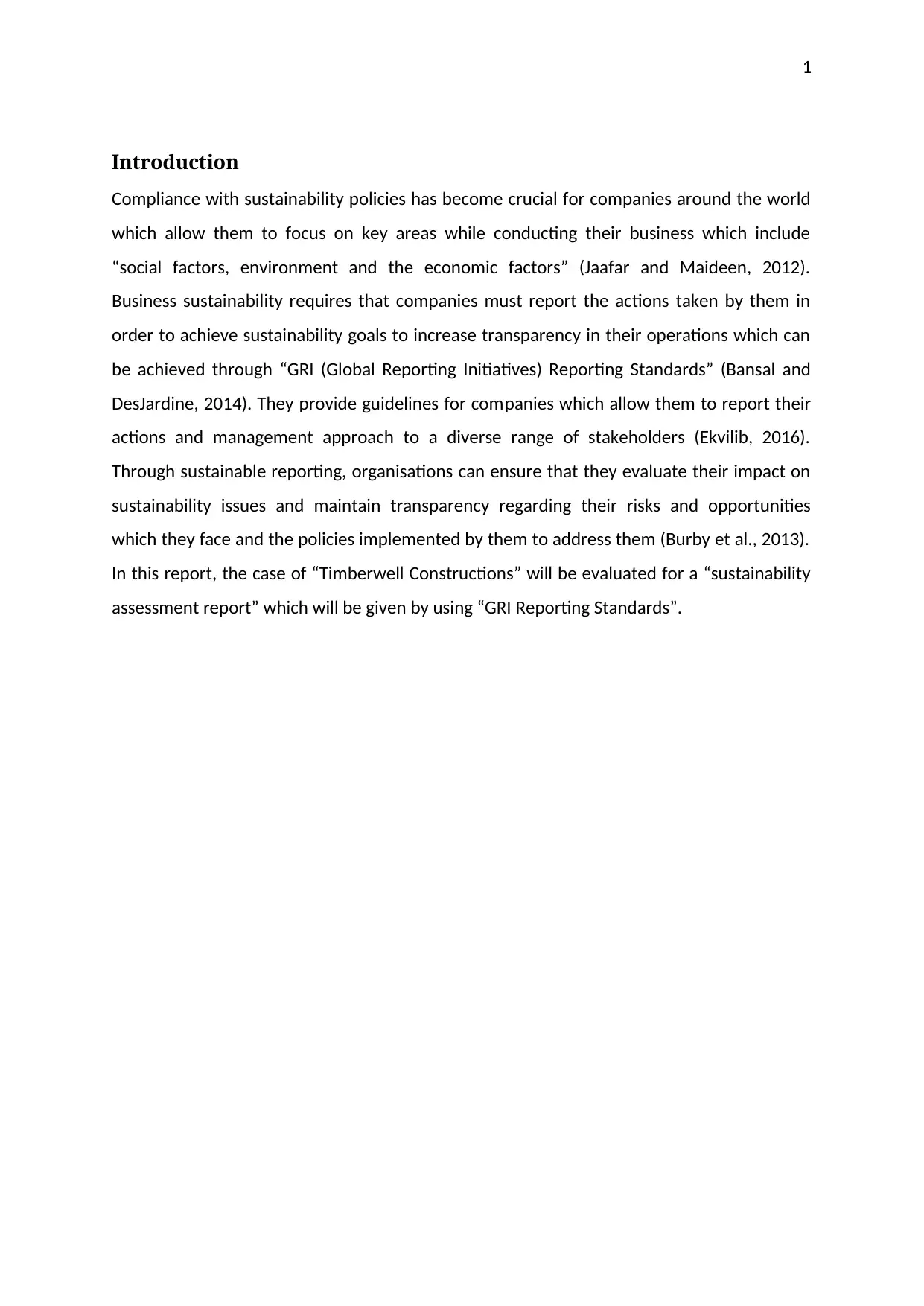
1
Introduction
Compliance with sustainability policies has become crucial for companies around the world
which allow them to focus on key areas while conducting their business which include
“social factors, environment and the economic factors” (Jaafar and Maideen, 2012).
Business sustainability requires that companies must report the actions taken by them in
order to achieve sustainability goals to increase transparency in their operations which can
be achieved through “GRI (Global Reporting Initiatives) Reporting Standards” (Bansal and
DesJardine, 2014). They provide guidelines for companies which allow them to report their
actions and management approach to a diverse range of stakeholders (Ekvilib, 2016).
Through sustainable reporting, organisations can ensure that they evaluate their impact on
sustainability issues and maintain transparency regarding their risks and opportunities
which they face and the policies implemented by them to address them (Burby et al., 2013).
In this report, the case of “Timberwell Constructions” will be evaluated for a “sustainability
assessment report” which will be given by using “GRI Reporting Standards”.
Introduction
Compliance with sustainability policies has become crucial for companies around the world
which allow them to focus on key areas while conducting their business which include
“social factors, environment and the economic factors” (Jaafar and Maideen, 2012).
Business sustainability requires that companies must report the actions taken by them in
order to achieve sustainability goals to increase transparency in their operations which can
be achieved through “GRI (Global Reporting Initiatives) Reporting Standards” (Bansal and
DesJardine, 2014). They provide guidelines for companies which allow them to report their
actions and management approach to a diverse range of stakeholders (Ekvilib, 2016).
Through sustainable reporting, organisations can ensure that they evaluate their impact on
sustainability issues and maintain transparency regarding their risks and opportunities
which they face and the policies implemented by them to address them (Burby et al., 2013).
In this report, the case of “Timberwell Constructions” will be evaluated for a “sustainability
assessment report” which will be given by using “GRI Reporting Standards”.
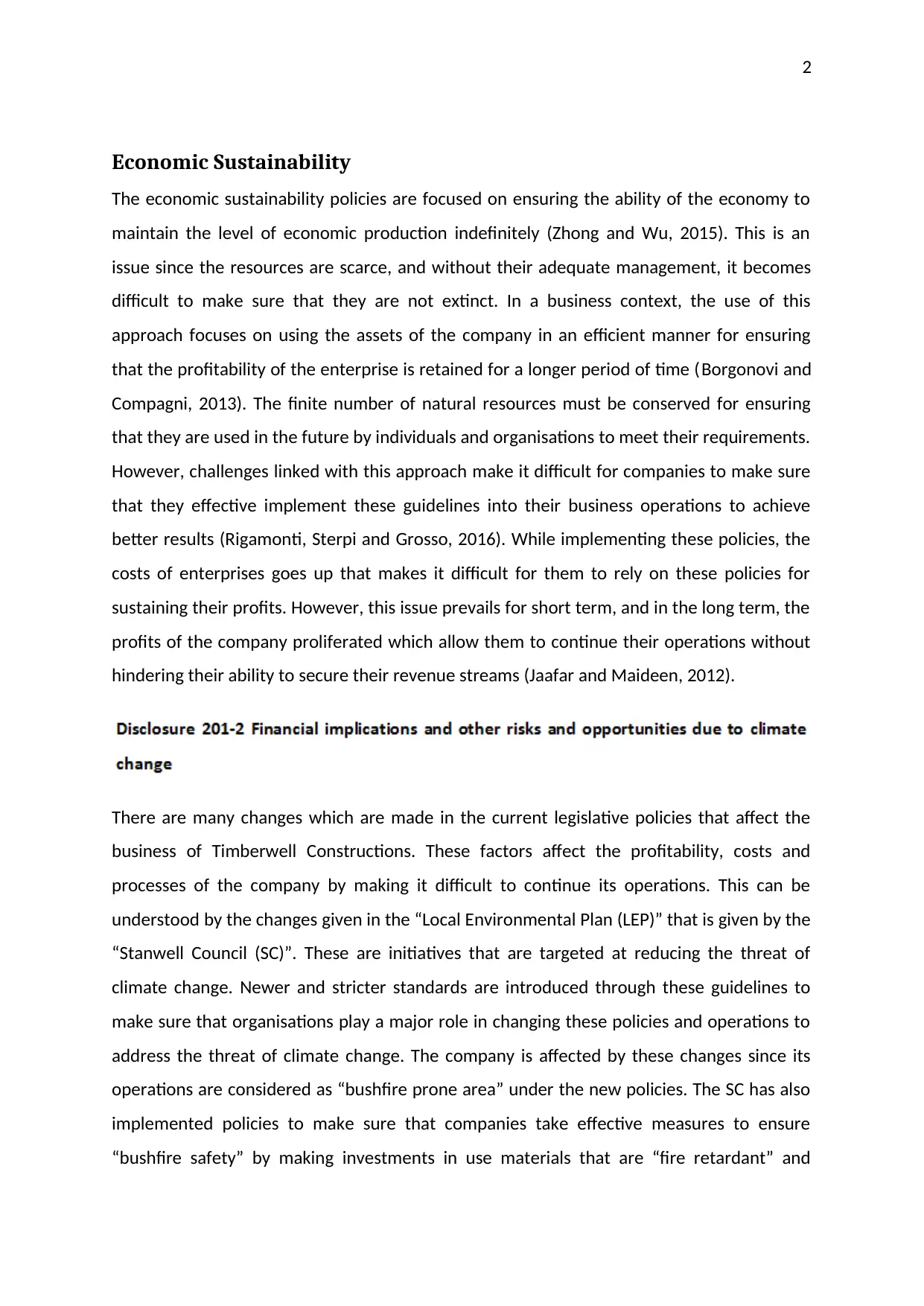
2
Economic Sustainability
The economic sustainability policies are focused on ensuring the ability of the economy to
maintain the level of economic production indefinitely (Zhong and Wu, 2015). This is an
issue since the resources are scarce, and without their adequate management, it becomes
difficult to make sure that they are not extinct. In a business context, the use of this
approach focuses on using the assets of the company in an efficient manner for ensuring
that the profitability of the enterprise is retained for a longer period of time (Borgonovi and
Compagni, 2013). The finite number of natural resources must be conserved for ensuring
that they are used in the future by individuals and organisations to meet their requirements.
However, challenges linked with this approach make it difficult for companies to make sure
that they effective implement these guidelines into their business operations to achieve
better results (Rigamonti, Sterpi and Grosso, 2016). While implementing these policies, the
costs of enterprises goes up that makes it difficult for them to rely on these policies for
sustaining their profits. However, this issue prevails for short term, and in the long term, the
profits of the company proliferated which allow them to continue their operations without
hindering their ability to secure their revenue streams (Jaafar and Maideen, 2012).
There are many changes which are made in the current legislative policies that affect the
business of Timberwell Constructions. These factors affect the profitability, costs and
processes of the company by making it difficult to continue its operations. This can be
understood by the changes given in the “Local Environmental Plan (LEP)” that is given by the
“Stanwell Council (SC)”. These are initiatives that are targeted at reducing the threat of
climate change. Newer and stricter standards are introduced through these guidelines to
make sure that organisations play a major role in changing these policies and operations to
address the threat of climate change. The company is affected by these changes since its
operations are considered as “bushfire prone area” under the new policies. The SC has also
implemented policies to make sure that companies take effective measures to ensure
“bushfire safety” by making investments in use materials that are “fire retardant” and
Economic Sustainability
The economic sustainability policies are focused on ensuring the ability of the economy to
maintain the level of economic production indefinitely (Zhong and Wu, 2015). This is an
issue since the resources are scarce, and without their adequate management, it becomes
difficult to make sure that they are not extinct. In a business context, the use of this
approach focuses on using the assets of the company in an efficient manner for ensuring
that the profitability of the enterprise is retained for a longer period of time (Borgonovi and
Compagni, 2013). The finite number of natural resources must be conserved for ensuring
that they are used in the future by individuals and organisations to meet their requirements.
However, challenges linked with this approach make it difficult for companies to make sure
that they effective implement these guidelines into their business operations to achieve
better results (Rigamonti, Sterpi and Grosso, 2016). While implementing these policies, the
costs of enterprises goes up that makes it difficult for them to rely on these policies for
sustaining their profits. However, this issue prevails for short term, and in the long term, the
profits of the company proliferated which allow them to continue their operations without
hindering their ability to secure their revenue streams (Jaafar and Maideen, 2012).
There are many changes which are made in the current legislative policies that affect the
business of Timberwell Constructions. These factors affect the profitability, costs and
processes of the company by making it difficult to continue its operations. This can be
understood by the changes given in the “Local Environmental Plan (LEP)” that is given by the
“Stanwell Council (SC)”. These are initiatives that are targeted at reducing the threat of
climate change. Newer and stricter standards are introduced through these guidelines to
make sure that organisations play a major role in changing these policies and operations to
address the threat of climate change. The company is affected by these changes since its
operations are considered as “bushfire prone area” under the new policies. The SC has also
implemented policies to make sure that companies take effective measures to ensure
“bushfire safety” by making investments in use materials that are “fire retardant” and
⊘ This is a preview!⊘
Do you want full access?
Subscribe today to unlock all pages.

Trusted by 1+ million students worldwide
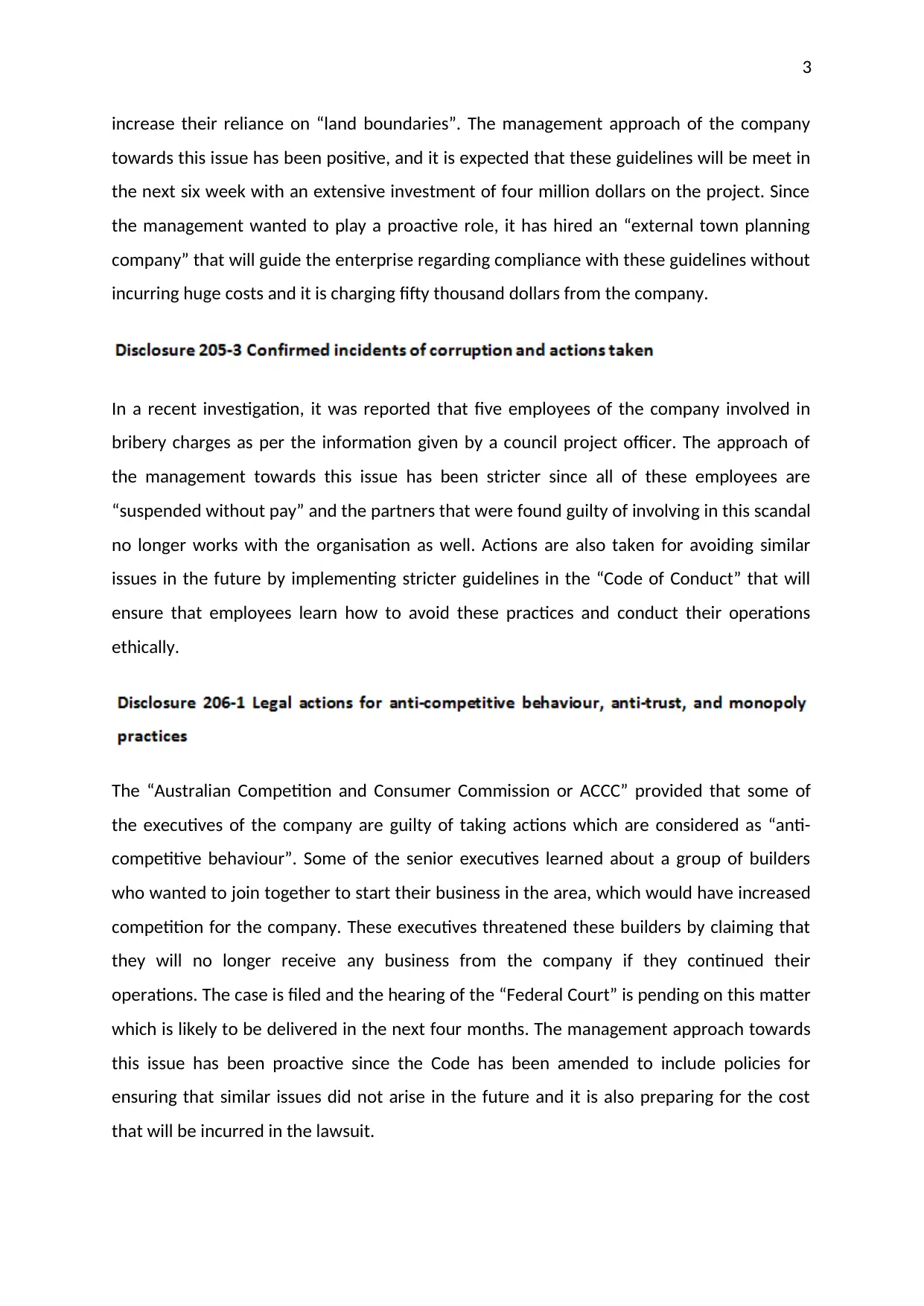
3
increase their reliance on “land boundaries”. The management approach of the company
towards this issue has been positive, and it is expected that these guidelines will be meet in
the next six week with an extensive investment of four million dollars on the project. Since
the management wanted to play a proactive role, it has hired an “external town planning
company” that will guide the enterprise regarding compliance with these guidelines without
incurring huge costs and it is charging fifty thousand dollars from the company.
In a recent investigation, it was reported that five employees of the company involved in
bribery charges as per the information given by a council project officer. The approach of
the management towards this issue has been stricter since all of these employees are
“suspended without pay” and the partners that were found guilty of involving in this scandal
no longer works with the organisation as well. Actions are also taken for avoiding similar
issues in the future by implementing stricter guidelines in the “Code of Conduct” that will
ensure that employees learn how to avoid these practices and conduct their operations
ethically.
The “Australian Competition and Consumer Commission or ACCC” provided that some of
the executives of the company are guilty of taking actions which are considered as “anti-
competitive behaviour”. Some of the senior executives learned about a group of builders
who wanted to join together to start their business in the area, which would have increased
competition for the company. These executives threatened these builders by claiming that
they will no longer receive any business from the company if they continued their
operations. The case is filed and the hearing of the “Federal Court” is pending on this matter
which is likely to be delivered in the next four months. The management approach towards
this issue has been proactive since the Code has been amended to include policies for
ensuring that similar issues did not arise in the future and it is also preparing for the cost
that will be incurred in the lawsuit.
increase their reliance on “land boundaries”. The management approach of the company
towards this issue has been positive, and it is expected that these guidelines will be meet in
the next six week with an extensive investment of four million dollars on the project. Since
the management wanted to play a proactive role, it has hired an “external town planning
company” that will guide the enterprise regarding compliance with these guidelines without
incurring huge costs and it is charging fifty thousand dollars from the company.
In a recent investigation, it was reported that five employees of the company involved in
bribery charges as per the information given by a council project officer. The approach of
the management towards this issue has been stricter since all of these employees are
“suspended without pay” and the partners that were found guilty of involving in this scandal
no longer works with the organisation as well. Actions are also taken for avoiding similar
issues in the future by implementing stricter guidelines in the “Code of Conduct” that will
ensure that employees learn how to avoid these practices and conduct their operations
ethically.
The “Australian Competition and Consumer Commission or ACCC” provided that some of
the executives of the company are guilty of taking actions which are considered as “anti-
competitive behaviour”. Some of the senior executives learned about a group of builders
who wanted to join together to start their business in the area, which would have increased
competition for the company. These executives threatened these builders by claiming that
they will no longer receive any business from the company if they continued their
operations. The case is filed and the hearing of the “Federal Court” is pending on this matter
which is likely to be delivered in the next four months. The management approach towards
this issue has been proactive since the Code has been amended to include policies for
ensuring that similar issues did not arise in the future and it is also preparing for the cost
that will be incurred in the lawsuit.
Paraphrase This Document
Need a fresh take? Get an instant paraphrase of this document with our AI Paraphraser
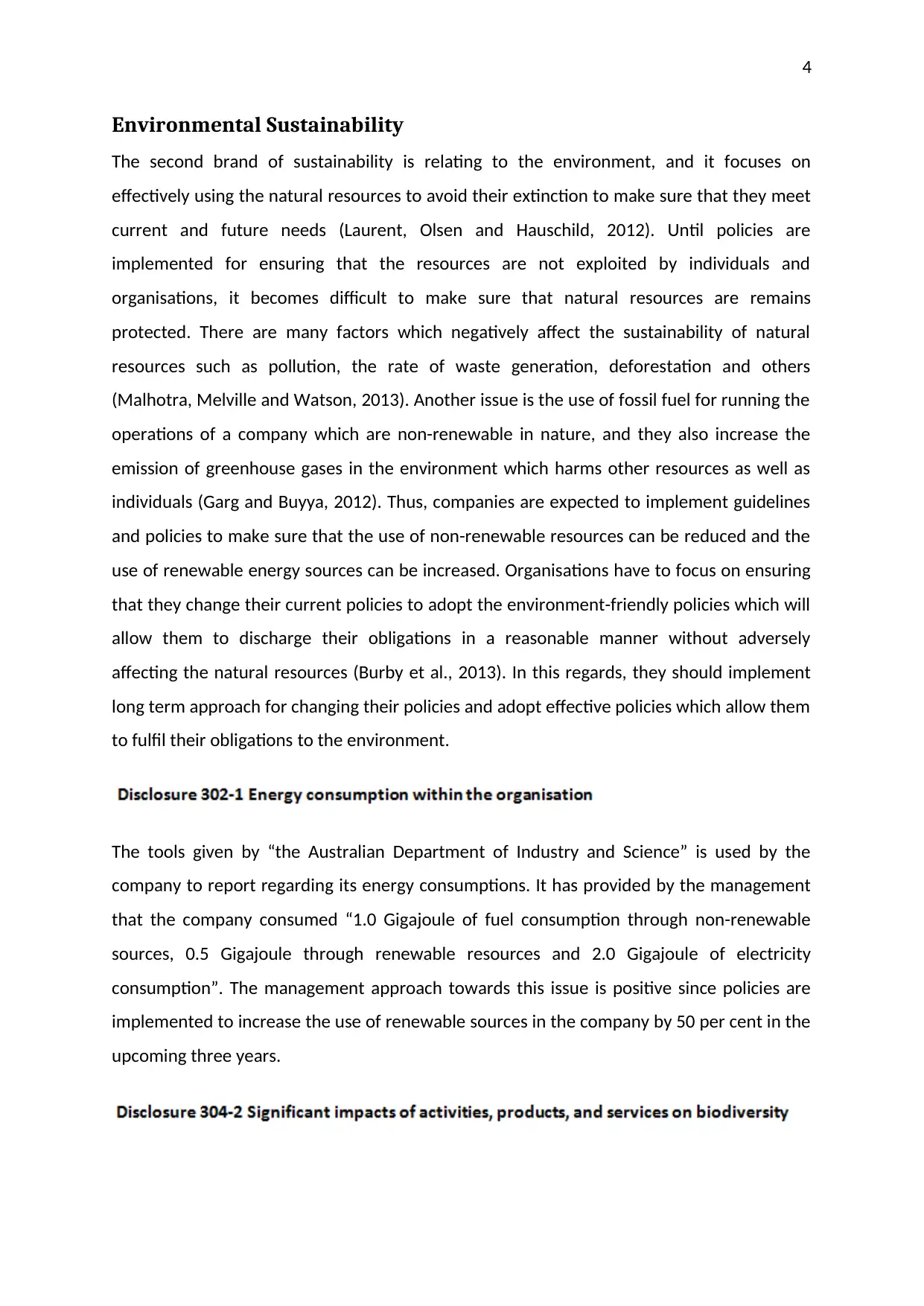
4
Environmental Sustainability
The second brand of sustainability is relating to the environment, and it focuses on
effectively using the natural resources to avoid their extinction to make sure that they meet
current and future needs (Laurent, Olsen and Hauschild, 2012). Until policies are
implemented for ensuring that the resources are not exploited by individuals and
organisations, it becomes difficult to make sure that natural resources are remains
protected. There are many factors which negatively affect the sustainability of natural
resources such as pollution, the rate of waste generation, deforestation and others
(Malhotra, Melville and Watson, 2013). Another issue is the use of fossil fuel for running the
operations of a company which are non-renewable in nature, and they also increase the
emission of greenhouse gases in the environment which harms other resources as well as
individuals (Garg and Buyya, 2012). Thus, companies are expected to implement guidelines
and policies to make sure that the use of non-renewable resources can be reduced and the
use of renewable energy sources can be increased. Organisations have to focus on ensuring
that they change their current policies to adopt the environment-friendly policies which will
allow them to discharge their obligations in a reasonable manner without adversely
affecting the natural resources (Burby et al., 2013). In this regards, they should implement
long term approach for changing their policies and adopt effective policies which allow them
to fulfil their obligations to the environment.
The tools given by “the Australian Department of Industry and Science” is used by the
company to report regarding its energy consumptions. It has provided by the management
that the company consumed “1.0 Gigajoule of fuel consumption through non-renewable
sources, 0.5 Gigajoule through renewable resources and 2.0 Gigajoule of electricity
consumption”. The management approach towards this issue is positive since policies are
implemented to increase the use of renewable sources in the company by 50 per cent in the
upcoming three years.
Environmental Sustainability
The second brand of sustainability is relating to the environment, and it focuses on
effectively using the natural resources to avoid their extinction to make sure that they meet
current and future needs (Laurent, Olsen and Hauschild, 2012). Until policies are
implemented for ensuring that the resources are not exploited by individuals and
organisations, it becomes difficult to make sure that natural resources are remains
protected. There are many factors which negatively affect the sustainability of natural
resources such as pollution, the rate of waste generation, deforestation and others
(Malhotra, Melville and Watson, 2013). Another issue is the use of fossil fuel for running the
operations of a company which are non-renewable in nature, and they also increase the
emission of greenhouse gases in the environment which harms other resources as well as
individuals (Garg and Buyya, 2012). Thus, companies are expected to implement guidelines
and policies to make sure that the use of non-renewable resources can be reduced and the
use of renewable energy sources can be increased. Organisations have to focus on ensuring
that they change their current policies to adopt the environment-friendly policies which will
allow them to discharge their obligations in a reasonable manner without adversely
affecting the natural resources (Burby et al., 2013). In this regards, they should implement
long term approach for changing their policies and adopt effective policies which allow them
to fulfil their obligations to the environment.
The tools given by “the Australian Department of Industry and Science” is used by the
company to report regarding its energy consumptions. It has provided by the management
that the company consumed “1.0 Gigajoule of fuel consumption through non-renewable
sources, 0.5 Gigajoule through renewable resources and 2.0 Gigajoule of electricity
consumption”. The management approach towards this issue is positive since policies are
implemented to increase the use of renewable sources in the company by 50 per cent in the
upcoming three years.
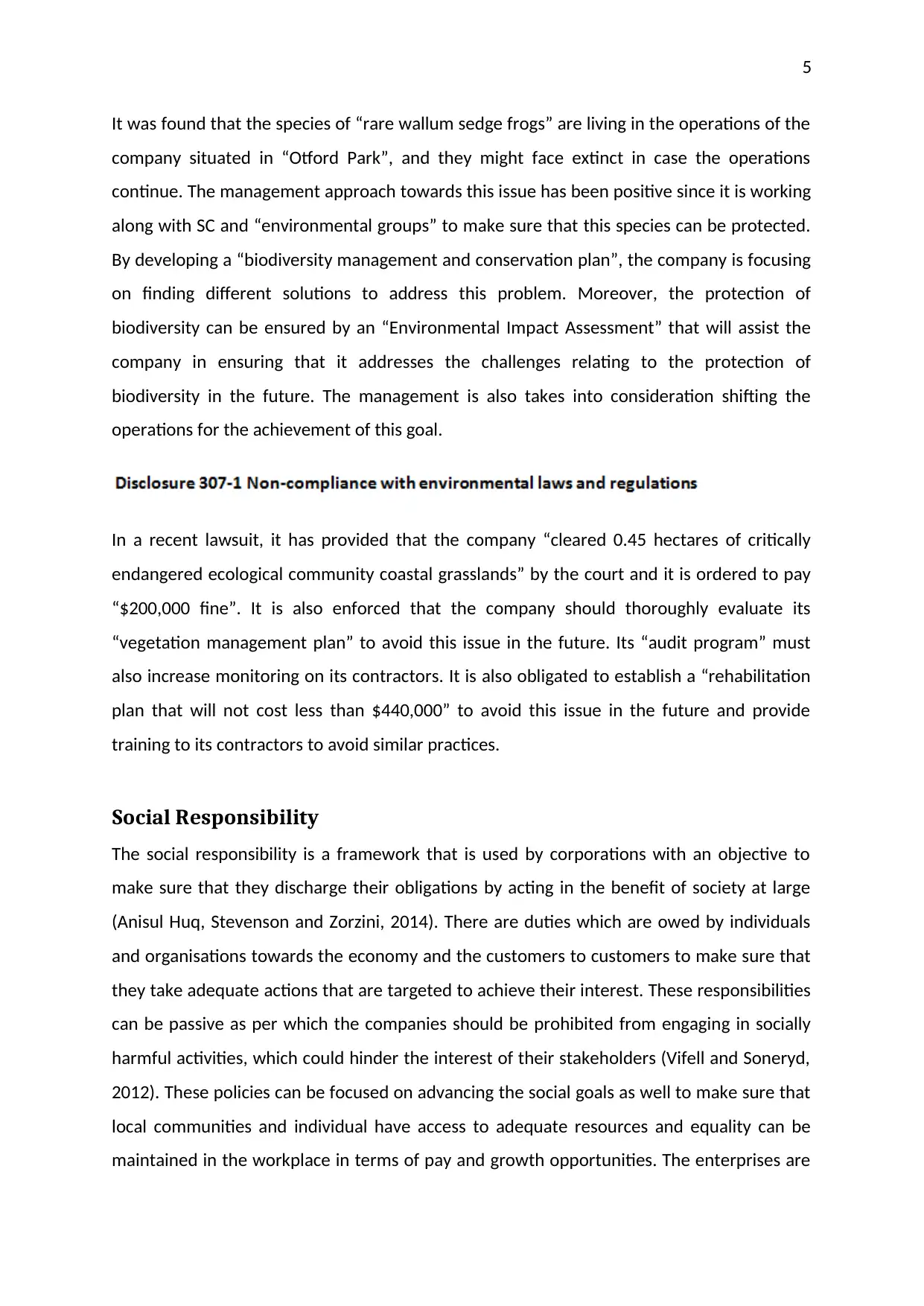
5
It was found that the species of “rare wallum sedge frogs” are living in the operations of the
company situated in “Otford Park”, and they might face extinct in case the operations
continue. The management approach towards this issue has been positive since it is working
along with SC and “environmental groups” to make sure that this species can be protected.
By developing a “biodiversity management and conservation plan”, the company is focusing
on finding different solutions to address this problem. Moreover, the protection of
biodiversity can be ensured by an “Environmental Impact Assessment” that will assist the
company in ensuring that it addresses the challenges relating to the protection of
biodiversity in the future. The management is also takes into consideration shifting the
operations for the achievement of this goal.
In a recent lawsuit, it has provided that the company “cleared 0.45 hectares of critically
endangered ecological community coastal grasslands” by the court and it is ordered to pay
“$200,000 fine”. It is also enforced that the company should thoroughly evaluate its
“vegetation management plan” to avoid this issue in the future. Its “audit program” must
also increase monitoring on its contractors. It is also obligated to establish a “rehabilitation
plan that will not cost less than $440,000” to avoid this issue in the future and provide
training to its contractors to avoid similar practices.
Social Responsibility
The social responsibility is a framework that is used by corporations with an objective to
make sure that they discharge their obligations by acting in the benefit of society at large
(Anisul Huq, Stevenson and Zorzini, 2014). There are duties which are owed by individuals
and organisations towards the economy and the customers to customers to make sure that
they take adequate actions that are targeted to achieve their interest. These responsibilities
can be passive as per which the companies should be prohibited from engaging in socially
harmful activities, which could hinder the interest of their stakeholders (Vifell and Soneryd,
2012). These policies can be focused on advancing the social goals as well to make sure that
local communities and individual have access to adequate resources and equality can be
maintained in the workplace in terms of pay and growth opportunities. The enterprises are
It was found that the species of “rare wallum sedge frogs” are living in the operations of the
company situated in “Otford Park”, and they might face extinct in case the operations
continue. The management approach towards this issue has been positive since it is working
along with SC and “environmental groups” to make sure that this species can be protected.
By developing a “biodiversity management and conservation plan”, the company is focusing
on finding different solutions to address this problem. Moreover, the protection of
biodiversity can be ensured by an “Environmental Impact Assessment” that will assist the
company in ensuring that it addresses the challenges relating to the protection of
biodiversity in the future. The management is also takes into consideration shifting the
operations for the achievement of this goal.
In a recent lawsuit, it has provided that the company “cleared 0.45 hectares of critically
endangered ecological community coastal grasslands” by the court and it is ordered to pay
“$200,000 fine”. It is also enforced that the company should thoroughly evaluate its
“vegetation management plan” to avoid this issue in the future. Its “audit program” must
also increase monitoring on its contractors. It is also obligated to establish a “rehabilitation
plan that will not cost less than $440,000” to avoid this issue in the future and provide
training to its contractors to avoid similar practices.
Social Responsibility
The social responsibility is a framework that is used by corporations with an objective to
make sure that they discharge their obligations by acting in the benefit of society at large
(Anisul Huq, Stevenson and Zorzini, 2014). There are duties which are owed by individuals
and organisations towards the economy and the customers to customers to make sure that
they take adequate actions that are targeted to achieve their interest. These responsibilities
can be passive as per which the companies should be prohibited from engaging in socially
harmful activities, which could hinder the interest of their stakeholders (Vifell and Soneryd,
2012). These policies can be focused on advancing the social goals as well to make sure that
local communities and individual have access to adequate resources and equality can be
maintained in the workplace in terms of pay and growth opportunities. The enterprises are
⊘ This is a preview!⊘
Do you want full access?
Subscribe today to unlock all pages.

Trusted by 1+ million students worldwide
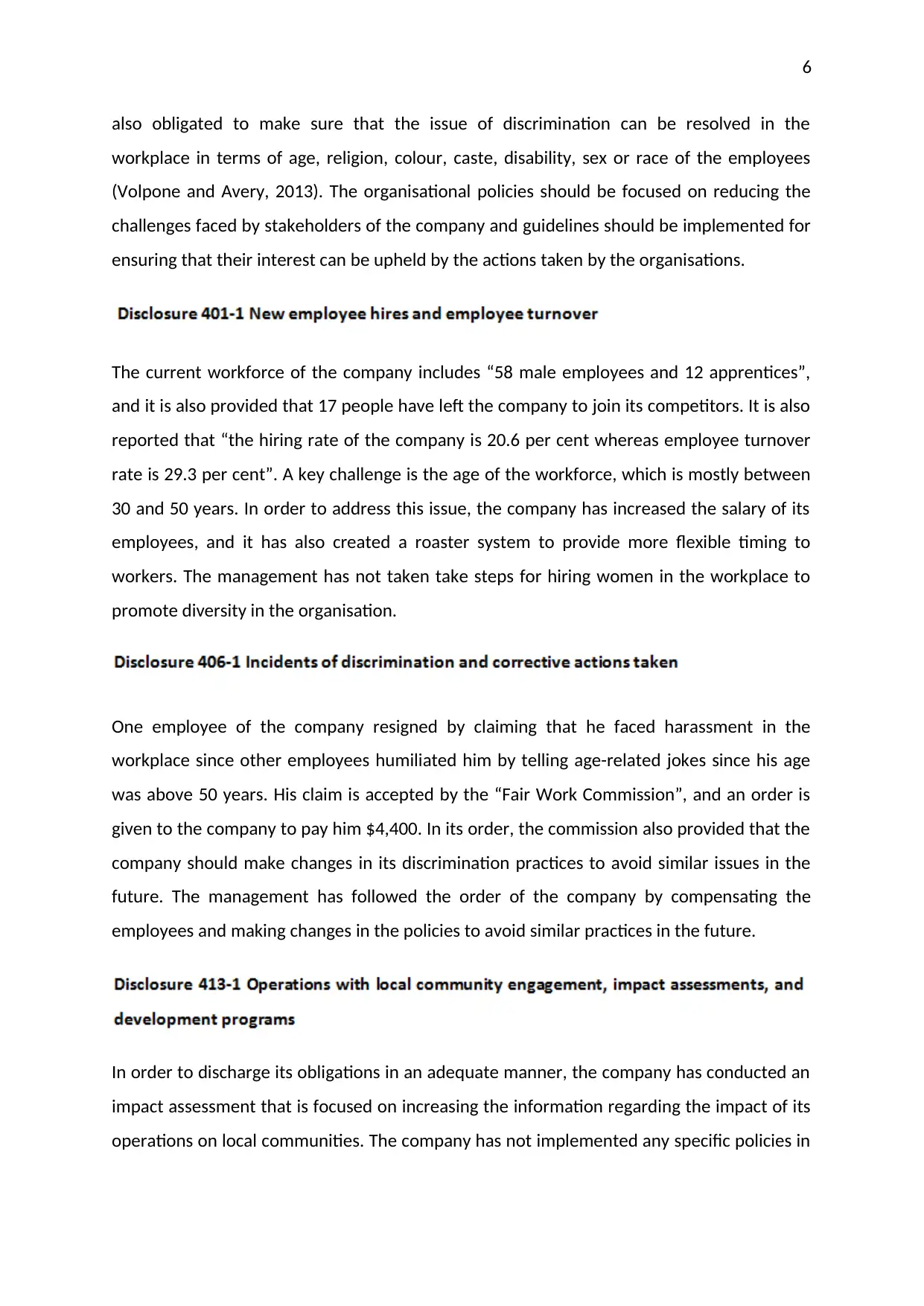
6
also obligated to make sure that the issue of discrimination can be resolved in the
workplace in terms of age, religion, colour, caste, disability, sex or race of the employees
(Volpone and Avery, 2013). The organisational policies should be focused on reducing the
challenges faced by stakeholders of the company and guidelines should be implemented for
ensuring that their interest can be upheld by the actions taken by the organisations.
The current workforce of the company includes “58 male employees and 12 apprentices”,
and it is also provided that 17 people have left the company to join its competitors. It is also
reported that “the hiring rate of the company is 20.6 per cent whereas employee turnover
rate is 29.3 per cent”. A key challenge is the age of the workforce, which is mostly between
30 and 50 years. In order to address this issue, the company has increased the salary of its
employees, and it has also created a roaster system to provide more flexible timing to
workers. The management has not taken take steps for hiring women in the workplace to
promote diversity in the organisation.
One employee of the company resigned by claiming that he faced harassment in the
workplace since other employees humiliated him by telling age-related jokes since his age
was above 50 years. His claim is accepted by the “Fair Work Commission”, and an order is
given to the company to pay him $4,400. In its order, the commission also provided that the
company should make changes in its discrimination practices to avoid similar issues in the
future. The management has followed the order of the company by compensating the
employees and making changes in the policies to avoid similar practices in the future.
In order to discharge its obligations in an adequate manner, the company has conducted an
impact assessment that is focused on increasing the information regarding the impact of its
operations on local communities. The company has not implemented any specific policies in
also obligated to make sure that the issue of discrimination can be resolved in the
workplace in terms of age, religion, colour, caste, disability, sex or race of the employees
(Volpone and Avery, 2013). The organisational policies should be focused on reducing the
challenges faced by stakeholders of the company and guidelines should be implemented for
ensuring that their interest can be upheld by the actions taken by the organisations.
The current workforce of the company includes “58 male employees and 12 apprentices”,
and it is also provided that 17 people have left the company to join its competitors. It is also
reported that “the hiring rate of the company is 20.6 per cent whereas employee turnover
rate is 29.3 per cent”. A key challenge is the age of the workforce, which is mostly between
30 and 50 years. In order to address this issue, the company has increased the salary of its
employees, and it has also created a roaster system to provide more flexible timing to
workers. The management has not taken take steps for hiring women in the workplace to
promote diversity in the organisation.
One employee of the company resigned by claiming that he faced harassment in the
workplace since other employees humiliated him by telling age-related jokes since his age
was above 50 years. His claim is accepted by the “Fair Work Commission”, and an order is
given to the company to pay him $4,400. In its order, the commission also provided that the
company should make changes in its discrimination practices to avoid similar issues in the
future. The management has followed the order of the company by compensating the
employees and making changes in the policies to avoid similar practices in the future.
In order to discharge its obligations in an adequate manner, the company has conducted an
impact assessment that is focused on increasing the information regarding the impact of its
operations on local communities. The company has not implemented any specific policies in
Paraphrase This Document
Need a fresh take? Get an instant paraphrase of this document with our AI Paraphraser
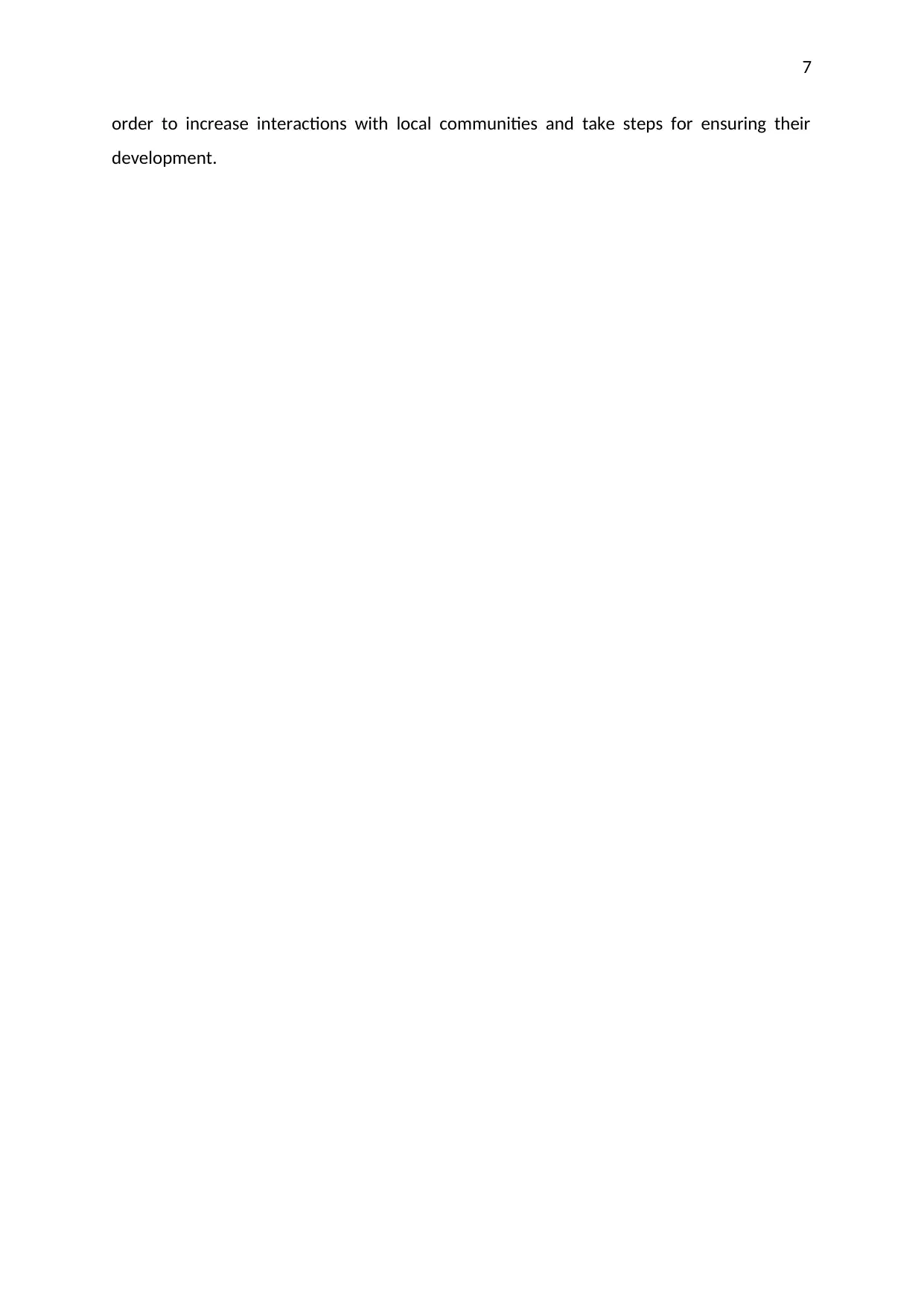
7
order to increase interactions with local communities and take steps for ensuring their
development.
order to increase interactions with local communities and take steps for ensuring their
development.
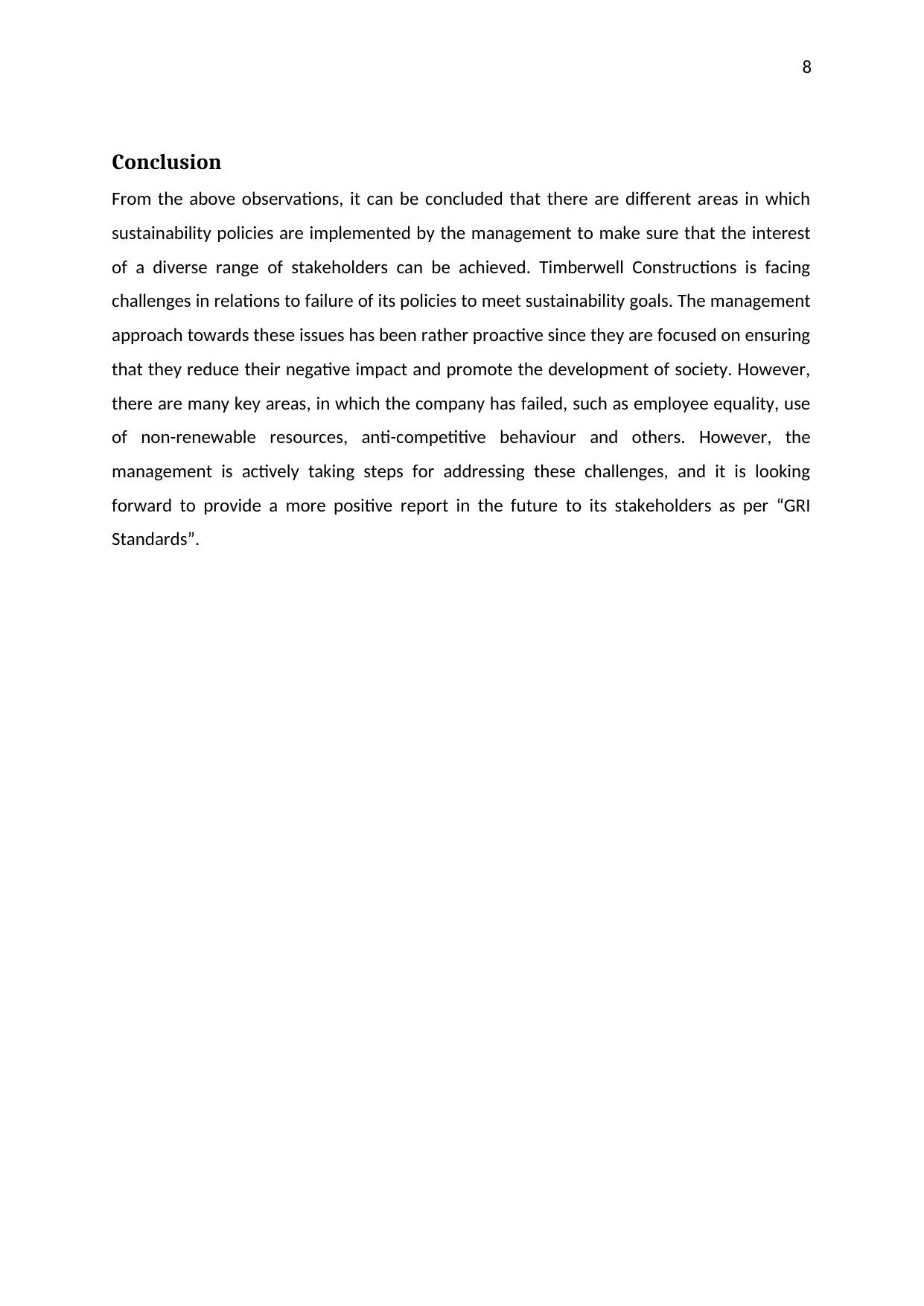
8
Conclusion
From the above observations, it can be concluded that there are different areas in which
sustainability policies are implemented by the management to make sure that the interest
of a diverse range of stakeholders can be achieved. Timberwell Constructions is facing
challenges in relations to failure of its policies to meet sustainability goals. The management
approach towards these issues has been rather proactive since they are focused on ensuring
that they reduce their negative impact and promote the development of society. However,
there are many key areas, in which the company has failed, such as employee equality, use
of non-renewable resources, anti-competitive behaviour and others. However, the
management is actively taking steps for addressing these challenges, and it is looking
forward to provide a more positive report in the future to its stakeholders as per “GRI
Standards”.
Conclusion
From the above observations, it can be concluded that there are different areas in which
sustainability policies are implemented by the management to make sure that the interest
of a diverse range of stakeholders can be achieved. Timberwell Constructions is facing
challenges in relations to failure of its policies to meet sustainability goals. The management
approach towards these issues has been rather proactive since they are focused on ensuring
that they reduce their negative impact and promote the development of society. However,
there are many key areas, in which the company has failed, such as employee equality, use
of non-renewable resources, anti-competitive behaviour and others. However, the
management is actively taking steps for addressing these challenges, and it is looking
forward to provide a more positive report in the future to its stakeholders as per “GRI
Standards”.
⊘ This is a preview!⊘
Do you want full access?
Subscribe today to unlock all pages.

Trusted by 1+ million students worldwide
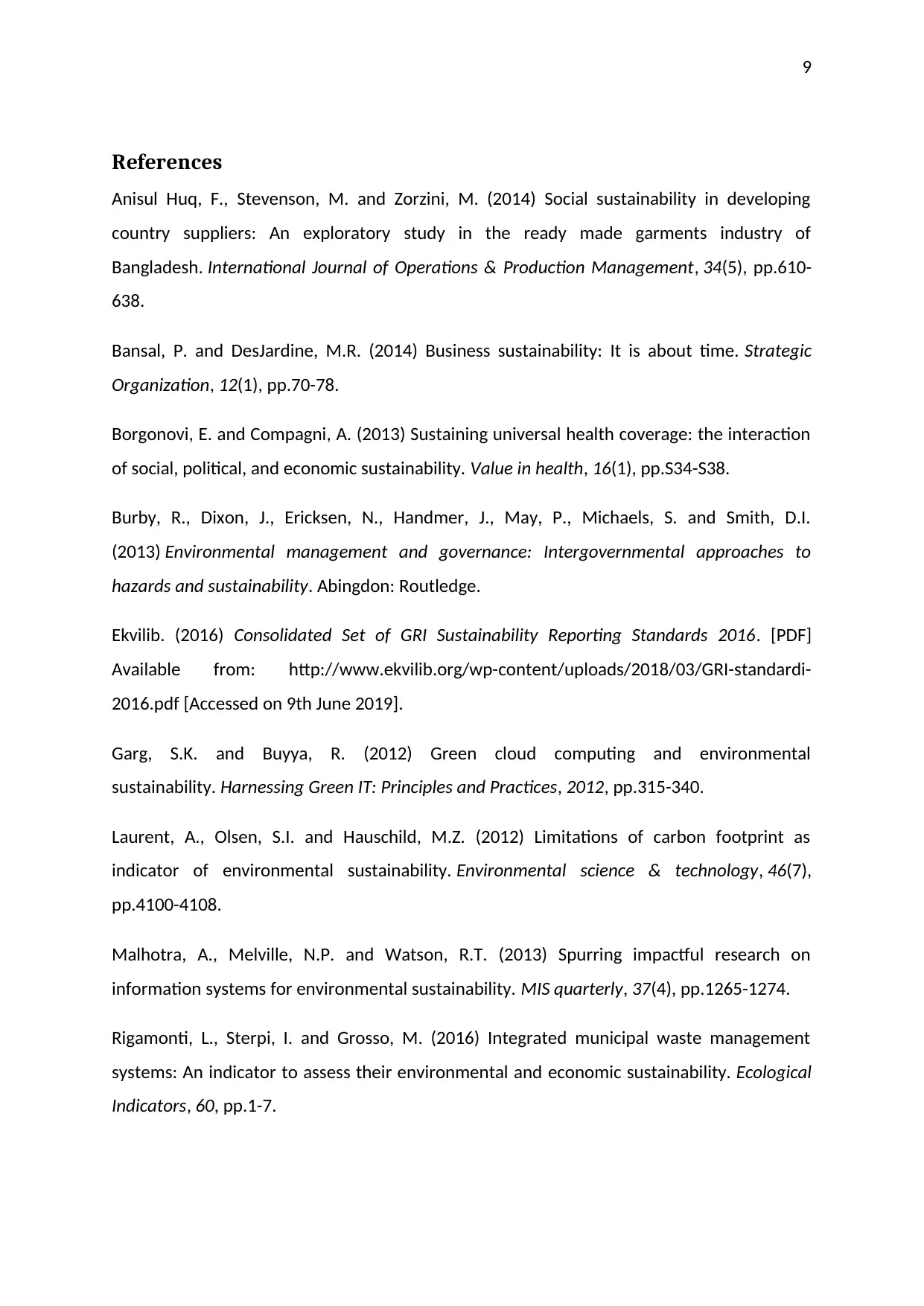
9
References
Anisul Huq, F., Stevenson, M. and Zorzini, M. (2014) Social sustainability in developing
country suppliers: An exploratory study in the ready made garments industry of
Bangladesh. International Journal of Operations & Production Management, 34(5), pp.610-
638.
Bansal, P. and DesJardine, M.R. (2014) Business sustainability: It is about time. Strategic
Organization, 12(1), pp.70-78.
Borgonovi, E. and Compagni, A. (2013) Sustaining universal health coverage: the interaction
of social, political, and economic sustainability. Value in health, 16(1), pp.S34-S38.
Burby, R., Dixon, J., Ericksen, N., Handmer, J., May, P., Michaels, S. and Smith, D.I.
(2013) Environmental management and governance: Intergovernmental approaches to
hazards and sustainability. Abingdon: Routledge.
Ekvilib. (2016) Consolidated Set of GRI Sustainability Reporting Standards 2016. [PDF]
Available from: http://www.ekvilib.org/wp-content/uploads/2018/03/GRI-standardi-
2016.pdf [Accessed on 9th June 2019].
Garg, S.K. and Buyya, R. (2012) Green cloud computing and environmental
sustainability. Harnessing Green IT: Principles and Practices, 2012, pp.315-340.
Laurent, A., Olsen, S.I. and Hauschild, M.Z. (2012) Limitations of carbon footprint as
indicator of environmental sustainability. Environmental science & technology, 46(7),
pp.4100-4108.
Malhotra, A., Melville, N.P. and Watson, R.T. (2013) Spurring impactful research on
information systems for environmental sustainability. MIS quarterly, 37(4), pp.1265-1274.
Rigamonti, L., Sterpi, I. and Grosso, M. (2016) Integrated municipal waste management
systems: An indicator to assess their environmental and economic sustainability. Ecological
Indicators, 60, pp.1-7.
References
Anisul Huq, F., Stevenson, M. and Zorzini, M. (2014) Social sustainability in developing
country suppliers: An exploratory study in the ready made garments industry of
Bangladesh. International Journal of Operations & Production Management, 34(5), pp.610-
638.
Bansal, P. and DesJardine, M.R. (2014) Business sustainability: It is about time. Strategic
Organization, 12(1), pp.70-78.
Borgonovi, E. and Compagni, A. (2013) Sustaining universal health coverage: the interaction
of social, political, and economic sustainability. Value in health, 16(1), pp.S34-S38.
Burby, R., Dixon, J., Ericksen, N., Handmer, J., May, P., Michaels, S. and Smith, D.I.
(2013) Environmental management and governance: Intergovernmental approaches to
hazards and sustainability. Abingdon: Routledge.
Ekvilib. (2016) Consolidated Set of GRI Sustainability Reporting Standards 2016. [PDF]
Available from: http://www.ekvilib.org/wp-content/uploads/2018/03/GRI-standardi-
2016.pdf [Accessed on 9th June 2019].
Garg, S.K. and Buyya, R. (2012) Green cloud computing and environmental
sustainability. Harnessing Green IT: Principles and Practices, 2012, pp.315-340.
Laurent, A., Olsen, S.I. and Hauschild, M.Z. (2012) Limitations of carbon footprint as
indicator of environmental sustainability. Environmental science & technology, 46(7),
pp.4100-4108.
Malhotra, A., Melville, N.P. and Watson, R.T. (2013) Spurring impactful research on
information systems for environmental sustainability. MIS quarterly, 37(4), pp.1265-1274.
Rigamonti, L., Sterpi, I. and Grosso, M. (2016) Integrated municipal waste management
systems: An indicator to assess their environmental and economic sustainability. Ecological
Indicators, 60, pp.1-7.
Paraphrase This Document
Need a fresh take? Get an instant paraphrase of this document with our AI Paraphraser
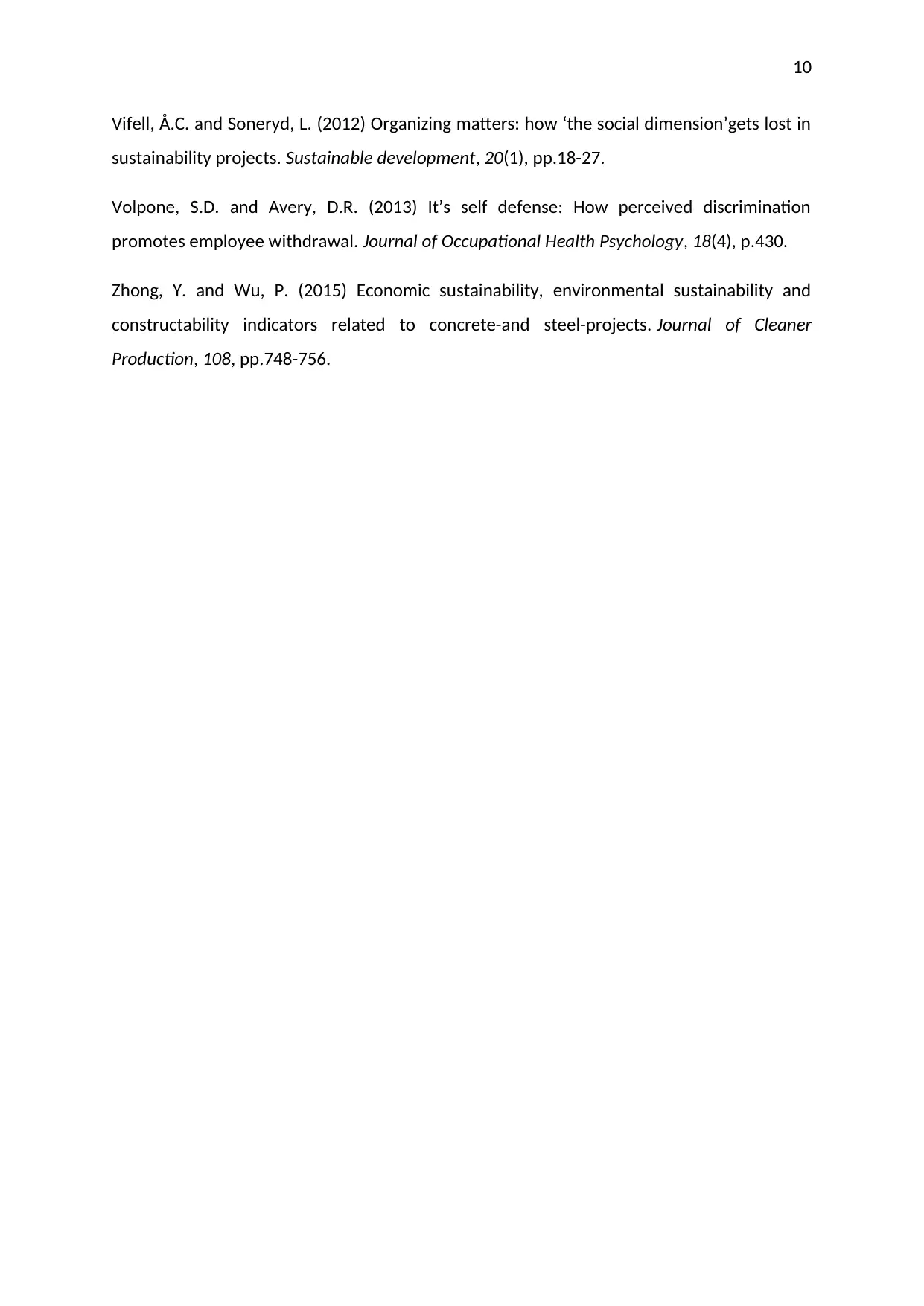
10
Vifell, Å.C. and Soneryd, L. (2012) Organizing matters: how ‘the social dimension’gets lost in
sustainability projects. Sustainable development, 20(1), pp.18-27.
Volpone, S.D. and Avery, D.R. (2013) It’s self defense: How perceived discrimination
promotes employee withdrawal. Journal of Occupational Health Psychology, 18(4), p.430.
Zhong, Y. and Wu, P. (2015) Economic sustainability, environmental sustainability and
constructability indicators related to concrete-and steel-projects. Journal of Cleaner
Production, 108, pp.748-756.
Vifell, Å.C. and Soneryd, L. (2012) Organizing matters: how ‘the social dimension’gets lost in
sustainability projects. Sustainable development, 20(1), pp.18-27.
Volpone, S.D. and Avery, D.R. (2013) It’s self defense: How perceived discrimination
promotes employee withdrawal. Journal of Occupational Health Psychology, 18(4), p.430.
Zhong, Y. and Wu, P. (2015) Economic sustainability, environmental sustainability and
constructability indicators related to concrete-and steel-projects. Journal of Cleaner
Production, 108, pp.748-756.
1 out of 11
Related Documents
Your All-in-One AI-Powered Toolkit for Academic Success.
+13062052269
info@desklib.com
Available 24*7 on WhatsApp / Email
![[object Object]](/_next/static/media/star-bottom.7253800d.svg)
Unlock your academic potential
Copyright © 2020–2025 A2Z Services. All Rights Reserved. Developed and managed by ZUCOL.




